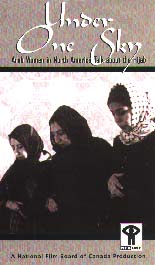|
________________
CM . . . .
Volume VII Number 7 . . . . December 1, 2000


|
Under One Sky: Arab Women in North America Talk About the Hijab.
Jennifer Kawaja (Director). Ginny Stikeman, Margaret Wong, Andree Lachapelle & Nicole
Hubert (Production Team).
Montreal, PQ: National Film Board of Canada, 1999.
40 min., 30 sec., VHS, $39.95.
Order Number: C9199 052.
Subject Headings:
Muslim women-Canada.
Identity.
Women in Islam.
Grades 7 and up / Ages 12 and up.
Review by Harriet Zaidman.
**** /4
|

The hijab, or head scarf, worn by Islamic women is the subject of this excellent documentary by
Jennifer Kawaja. The film documents the prejudice Muslim women experience in North America
because they choose to cover their heads according to Arabic custom. Islamic women who
observe this custom have been the brunt of discrimination, especially since the Gulf War which
demonized Arabic culture. Women have experienced taunts, ostracism, physical attacks and have
even been officially banned from wearing the hijab in schools in some locations.
Under One Sky presents the viewpoints of women who wear the hajib and those who do not.
While each has her reason for dressing the way she does, most generally see the hijab as an
expression of fidelity to Arab culture, to Islam, and as a statement against imperialism and
colonialism. They view it as a matter of choice and refuse to be buttonholed as a certain type of
person. The film shows young women wearing the hijab participating in pro-abortion and feminist
activities. They are opposed to violence against women who are veiled in North America and also
violence against women in Algeria for women who choose not wear it. But they refuse to back
down and dress "neutrally" (like a typical North American) because of the pressures exerted by
society.
The film discusses the background for the Western perception of the veil. Old Hollywood film
footage depicts enslaved mystical sexual beings in harems who needed to be liberated by the
British or American superhero. History became even more complicated as the Arabic upper
classes took off the hijab as their countries "modernized" (Westernized) and the veil was
identified with the poor and lower classes. Generally, Western attitudes held that women who
wore the veil were inferior and less intelligent, and the backlash created by people who want to
refute the arrogance of Western "liberation" and regain their cultural identity led to a resurgence
of interest in Islam and Islamic traditions.
Non-veiled women discuss their views and observe that, in order to act against racism and
imperialism, it becomes necessary for them to defend the right of women to wear something they
believe is oppressive. The actions and views of the different groups in the film show the changing
world in which Muslim women live. Veiled young women in Montreal are seen challenging
traditions by conducting their own prayer service, a traditionally male domain. And, at the end of
the film, one of the young women who donned the hijab before moving to Canada is now seen
without it, saying she now feels more herself. Her friends are not critical but defend their personal
need to wear the hijab.
This 43-minute documentary would be a useful catalyst for discussion among junior high and high
school students. The young women interviewed are articulate, intelligent and analytical. They are
excellent role models for girls and anyone who feels negative pressure from their peer group.
Teachers can generate discussion about accepting differences in dress and beliefs. Support from
teachers can relieve a great deal of anxiety for Islamic teens who wear the hijab, for anyone who
is perceived to be "different."
Highly recommended.
Harriet Zaidman is a teacher-librarian in Winnipeg, MB.

To comment on this title or this review, send mail to cm@umanitoba.ca.
Copyright © the Manitoba Library Association.
Reproduction for personal use is permitted only if this copyright notice
is maintained. Any other reproduction is prohibited without
permission.
Published by
The Manitoba Library Association
ISSN 1201-9364
TABLE OF CONTENTS FOR THIS ISSUE - December 1, 2000.
AUTHORS |
TITLES |
MEDIA REVIEWS |
PROFILES |
BACK ISSUES |
SEARCH |
ORDER |
CMARCHIVE |
HOME
|
